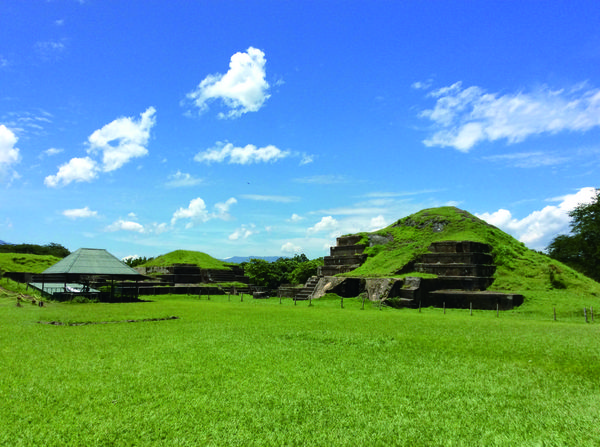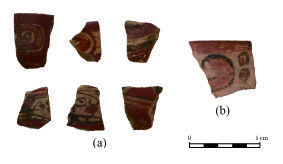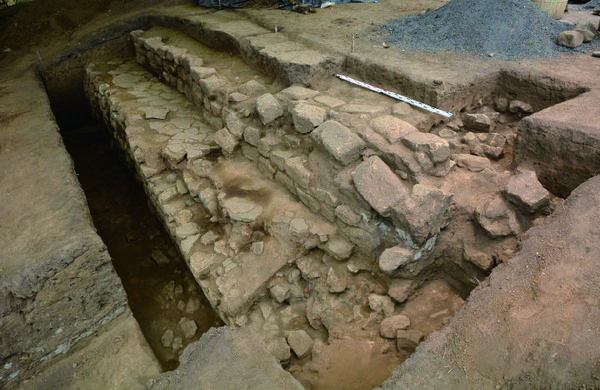Features
Features
The Effects on Ancient Maya Society of the Catastrophic Holocene-epoch Eruption of Ilopango
- ツイート
- 2017/11/09
Graduate School of Letters / IAR
Designated Assistant Professor Akira Ichikawa
Source: IAR Letter, vol.15, March 2017
*about IAR: Nagoya University's Institute for Advanced Research was established to produce internationally recognized academic research of the highest caliber, and to contribute to society through the research achievements at the Institute.
 Acrópolis, SanAndrés, El Salvador.
Acrópolis, SanAndrés, El Salvador.
There is no doubt that natural disasters have brought sudden environmental and cultural changes, and have impacted current and past human societies. Archaeology provides excellent evidence on these topics. However, scholars have far too often simply emphasized natural disasters as dramatic and fatal events, while human responses to and resilience in the face of natural disasters have been underestimated. Using the case study of the San Andrés site located in the southeastern Maya area, I highlight that we need to conduct careful case-by-case examinations of the effects of disasters.
INTRODUCTION
Natural disasters are an important concern for the modern world due to the huge loss of life they cause. Although most natural disaster studies are still dominated by natural scientists, social scientists have recently entered this arena to better understand the human response to hazardous events and sudden environmental change. Archaeology is especially recognized as one of the key disciplines in the advancement of disaster studies, since archaeological research can trace past human responses and the correlation of disasters with cultural change from a long-term perspective.
Ironically, archaeologists often benefit from volcanic disasters because the eruptive products of the eruption--such as pyroclastic flow, ash-fall tephra, etc.--can preserve the artifacts of ancient daily lives in excellent condition. In addition, the widespread emitted volcanic ash is often useful in accurately dating finds. On the other hand, volcanoes are especially dangerous hazards as they are unpredictable, sudden, and often have catastrophic effects on current and past human societies. Scholars have often emphasized that volcanic eruptions are critical events for human societies. However, we can also observe long-term human activities in volcanic areas. The purpose of our study is to better understand the correlation between volcanic activity and human response, as well as the resultant cultural and social shifts, based on archaeological investigation of the southeastern Maya area, specifically the Zapotitán Valley in El Salvador.
Geological Setting and Eruption of Ilopango Volcano
The Zapotitán Valley, located in central El Salvador, has experienced numerous explosive events over the past two millennia. One of these volcanic events was the eruption of Ilopango Volcano. Although the dating and effects are still under discussion (1), this eruption occurred in the 5th--6th centuries AD, and is well known as the most catastrophic New World eruption during the Holocene (2). For several decades, many scholars have argued that the Ilopango eruption resulted in serious sudden environmental changes and social problems in bordering regions, including the Zapotitán Valley, with many sites being abandoned for at least half a century or even a few centuries. Recent archaeological investigation of SanAndrés in the Zapotitán Valley located c. 45km from Ilopango Volcano, however, provides new insights and hypotheses regarding human responses to its catastrophic eruption.
Volcanic Disaster and Construction of Monumental Architecture
Based on archaeological evidence at SanAndrés, I hypothesize that the construction of monumental architecture was the motivating force behind the recovery process from the catastrophic natural events. Our team excavated the platform of Structure-5, the largest monumental architecture at the site, which consists of a 13m-tall pyramid on top of a 7m-tall platform, approximately 90m from north to south by 80m from east to west. In general, Maya monumental architecture consists of a superimposed series of constructions. Excavations revealed at least three construction phases of the platform of Structure-5, the first of which is masonry architecture, which was constructed on top of volcanic ash layers of approx. 40cm thick spewed out in the eruption of Ilopango Volcano. This masonry architecture was covered by adobe construction. Previously, it was considered that this earthen architecture was constructed several decades or centuries after the catastrophic eruption. However, the masonry architecture between the volcanic Ilopango ash and the adobe architecture indicates that ancient people returned to the Zapotitán Valley more rapidly than previously thought.
Masonry architecture constructed after the eruption of Ilopango Volcano.
Volcanoes are an important element in Maya cosmological concepts. Monumental architecture usually represented a "sacred mountain" and was an important symbol of community identity. Therefore, I consider that the collaborative actions in constructing monumental architecture might have reinforced not only elite power but also the social relationships between community members, in this case the victims of the eruption, and motivated people during the post-eruption recovery process.
Social Networks as a Mitigation Strategy
Networks are highly important socioeconomically in studies of ancient societies. At the same time, I highlight the importance of interregional and social networks to mitigate or overcome the damage of natural disasters. Establishing and maintaining broader social networks contributes to mitigating impacts over time and building resilient societies.
In the case of San Andrés, the masonry architecture mentione above is key evidence in identifying support for the affected society from other regions. Generally, in the southeastern Maya region (present-day El Salvador) both monumental and household architecture consisted of earthen materials like adobe brick and mud plaster. Therefore, the masonry architecture that was constructed after the eruption should be regarded as significantly different, because people needed new concepts, techniques, and labor organization for these construction activities. Furthermore, ceramic types also dramatically changed after the eruption. I hypothesize that these data indicate reconstruction support from another social group. One candidate is Quelepa, located about 130km east of San Andrés, a settlement demonstrating similar architectural components. Another possibility is Copán, one of the most powerful dynasties in the Classic Mayan realm, because San Andrés is considered to have been a satellite center of the Copán dynasty.
 |
Ceramic sherds related to Copán (a: Copador Polychrome) and Quelepa (b: Quelepa Polychrome). |
Concluding Remarks
Generally, defining direct connections between sudden environmental change and cultural practices is complicated by a number of factors. However, volcanic products like thick ash fall are easily identified in archaeological sites. In this sense, archaeological data on the gigantic eruption of Ilopango permit a deeper discussion of the impact of natural disasters on human societies. Although the hypothesis mentioned previously still needs to be verified, constructions of monumental architecture and social networks in ancient Maya societies could have had special roles and probably played these roles in response to natural disasters.
Acknowledgements
This study was fully authorized and assisted by Dirección Nacional de Patrimonio Cultural y Natural, la Secretaría de Cultura de la Presidencia, El Salvador. MEXT KAKENHI (No. 26101003) and DAIKO Foundation (No.11029) financially supported this study.
References
(1) Ichikawa, A. "Cuándo y cómo fue la erupción del volcán Ilopango, El Salvador: Síntesis desde la óptica arqueológica." JSL 12: 23-43 (2016).
(2) Dull, R ., J.R . Southon, and P. Sheets. " Volcanism, ecolog y and culture: A reassessment of the Volcan Ilopango TBJ eruption in the southern Maya realm." Latin American Antiquity 12: 25-44 (2001).
 |
Akira Ichikawa: Designated Assistant Professor of the Young Leaders Cultivation Program Graduate School of Letters / Institute of Advanced Research, Nagoya University |
Related Links
- download IAR_letter_Ichikawa.pdf
- "How Southeastern Mayan people overcame the catastrophic eruption of Ilopango? ", NU Research, June 1st, 2016
NU Research
(English)


